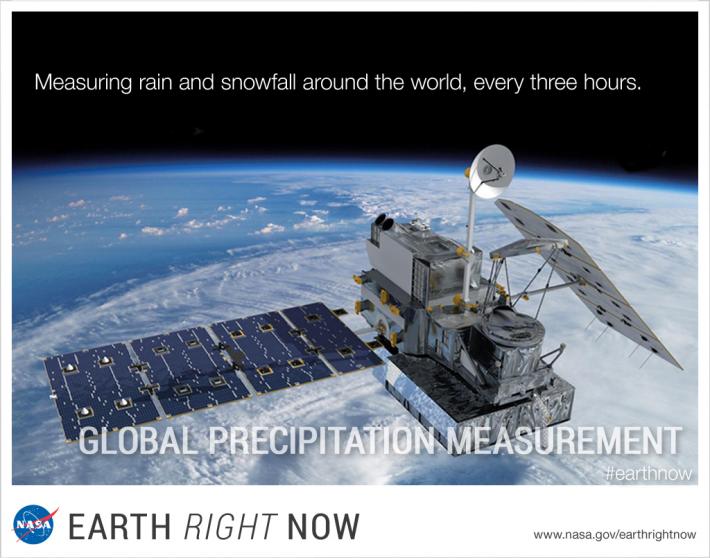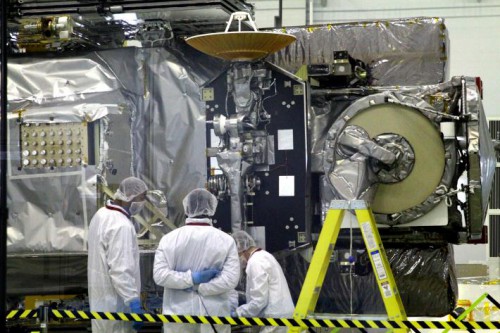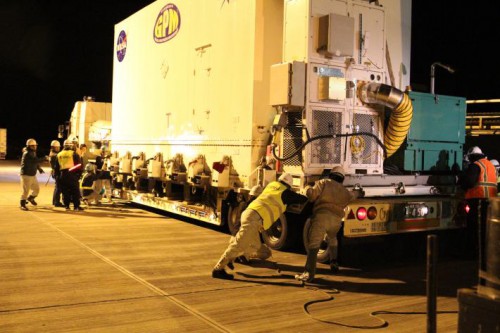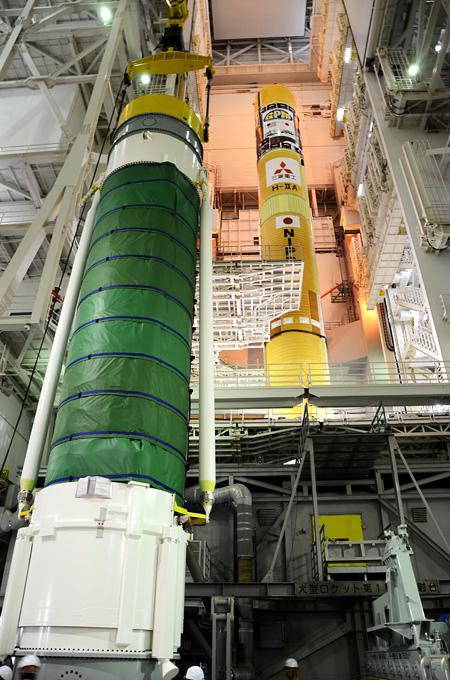
An ambitious mission to monitor Earth’s precipitation levels in unparalleled depth is scheduled for launch from the Tanegashima Space Centre—situated on the Pacific coastline of southeastern Tanegashima, one of the Ōsumi islands of southern Japan—at 3:07 a.m. JST Friday, 28 February (1:07 p.m. EST Thursday, 27 February). The Global Precipitation Measurement (GPM) Core Observatory will ride into an orbit of 253 miles (407 km), atop Japan’s H-IIA booster, to observe the two-dimensional and three-dimensional structure of Earth’s precipitation patterns. It will produce a single, comprehensive data set every 2-3 hours and provide a new calibration standard for a “constellation” of international weather-watching missions. In doing so, it forms part of an effort to accurately measure rainfall and snowfall on a global scale and better understand the impact of extreme weather and provide more effective responses to natural disasters.
The GPM Core Observatory is a joint venture between NASA—whose Goddard Space Flight Center of Greenbelt, Md., built the spacecraft—and the Japan Aerospace Exploration Agency (JAXA), which has supplied one of its two scientific instruments. It will also feature collaboration with the Department of Defense’s Defense Meteorological Satellite Program (DMSP), the National Oceanic and Atmospheric Administration (NOAA), the Indian Space Research Organisation (ISRO), the European Organisation for the Exploitation of Meteorological Satellites, and the Centre National d’Etudes Spatiales (the French National Space Centre, CNES). The GPM Core Observatory is an integral component of NASA’s Earth Systemic Missions program and will work as part of a network of satellites to provide full global coverage and assist with ongoing research into the processes of climate change, the forecasting of extreme weather events, and the addition of new capabilities to benefit society as a whole.

One of the satellites involved in the project is the highly successful Tropical Rainfall Monitoring Mission (TRMM), another joint NASA-JAXA venture, launched from Tanegashima in November 1997 to examine rainfall in the tropics. Still operational today, TRMM employs radar and visible, infrared, and microwave imaging sensors to monitor storm structures and lightning and provide data on the intensity and distribution of rainfall, together with energy levels in the atmosphere and at Earth’s surface. Working together with TRMM and several other missions—including the 2011-launched Suomi National Polar-Orbiting Partnership (NPP) satellite—the GPM Core Observatory will extend their capabilities by operating at much higher latitudes and with much higher resolution. It will operate at an orbital inclination of 65 degrees, which enables it to cover the globe from the Arctic to the Antarctic Circles. Consequently, it will study precipitation levels across this broad expanse of latitude and observe changing storm and weather systems by day and night.
In fact, TRMM research highlighted the importance of taking measurements at different times of day, in order to improve the accuracy of weather systems and hurricane monitoring in real time. According to Michael Freilich, director of NASA’s Earth Sciences Division at the agency’s Washington, D.C., headquarters, the GPM mission is “vitally important for environmental research and weather forecasting.” Responding to natural disasters, added JAXA’s executive director, Shizuo Yamamato, could also aid Asian countries hit by devastating floods, through the provision of data for advanced alert systems. “Knowing rain and snow amounts accurately over the whole globe is critical to understanding how weather and climate impact agriculture, fresh water availability and responses to natural disasters,” Freilich explained.

Key to this capability is the GPM Core Observatory’s Dual-Frequency Precipitation Radar (DPR). Provided by JAXA, this instrument will produce three-dimensional maps of storm structures across its swath, including the intensity of rainfall and snowfall at the surface. Operating at two frequencies—Ku-band and Ka-band—it will allow meteorologists to estimate the size of precipitation particles and detect a wide range of rainfall and snowfall rates. The Ku-band element will cover a swath of 152 miles (245 km), whilst its Ka-band counterpart covers 74.5 miles (120 km). A second instrument, the GPM Microwave Imager (GMI), has been built by Ball Aerospace, under contract to NASA-Goddard, and will provide passive sensing of the microwave energy emitted by the atmosphere at 13 different frequency/polarization channels. This is expected to permit the construction of quantitative maps of precipitation across a 550-mile (885 km) swath.
The size of a small private jet, the GPM Core Observatory is the largest satellite ever built at NASA-Goddard. Following extensive thermal vacuum chamber tests and solar array deployment tests, it was transferred to Joint Base Andrews in Prince George’s County, Md., whereupon it was loaded aboard a U.S. Air Force C-5 transport aircraft for delivery to Japan. On 21 November 2013, the C-5 left Joint Base Andrews for the 7,300-mile (11,750-km) journey. Crossing the continental United States and performing a refueling stop in Anchorage, Alaska, the aircraft continued across the Pacific Ocean and touched down at Kitakyushu Airport, about 600 miles (960 km) southwest of Tokyo, on 24 November. The GPM Core Observatory was then delivered by cargo ship from the airport to the Tanegashima Space Centre. Shortly after its arrival at the launch site, the satellite underwent a Comprehensive Performance Test (CPT) in December 2013, which involved end-to-end testing of its 30 systems. Spacecraft alignments, including measurements of the GPM Core Observatory’s star trackers and thrusters, continued into January.

In the meantime, efforts to ready the giant H-IIA launch vehicle were gathering pace. On 20 January, the components for the two-stage rocket arrived at Tanegashima for final processing. Earlier this month the two strap-on Solid Rocket Boosters (SRBs) were attached to the H-IIA, and on 13 February the GPM Core Observatory was encapsulated within its payload fairing, ahead of integration with the rocket. Unlike the encapsulation procedures normally followed by U.S. rockets (in which a two-piece payload fairing is closed, like a clamshell, around the payload), the satellite and its Payload Attach Fitting (PAF) were first set up in scaffolding in the Encapsulation Hall, after which the fairing was lifted above the PAF. With stanchions supporting the fairing, technicians established electrical connections, after which the fairing was lowered and bolted into position. Final activities and checks concluded on 16 February, and the payload was transferred to the Vehicle Assembly Building (VAB) on the 18th.
Built by Mitsubishi Heavy Industries, the H-IIA is one of the most reliable launch vehicles in the world. Its 95-percent success rate—with 21 successful flights and one failure, since its maiden voyage in August 2001—positions it favorably in the same league as United Launch Alliance’s (ULA) Atlas V and Europe’s Ariane 5. Standing 173 feet (53 meters) tall, the two-stage rocket can deliver up to 33,000 pounds (15,000 kg) into low-Earth orbit and up to 13,227 pounds (6,000 kg) into geostationary transfer orbit. Over the last decade, it has lofted numerous payloads, most notably Japan’s Selenological and Engineering Explorer (SELENE) lunar orbiter in September 2007 and the Planet-C mission to Venus in May 2010.
This week’s launch will occur during a 120-minute “window,” which opens at 3:07 a.m. JST Friday, 28 February (1:07 p.m. EST Thursday, 27 February). About 12 hours ahead of liftoff, a “Go” from mission managers will authorize the rollout of the H-IIA from the assembly building. Upon arrival at the pad, engineers will begin hooking up electrical and fluid connections and at X-7 hours and 45 minutes the loading of liquid oxygen and hydrogen propellants into the cryogenic first and second stages of the rocket will get underway. In addition to the two stages, the rocket will be powered uphill by the two SRBs. Sixty minutes before launch, a final “Go” to proceed will be issued and the countdown will enter its “Terminal Countdown Sequence,” during which period the H-IIA will transfer its systems to internal power and all cryogenic propellants will be verified at their correct flight pressures.
At the instant of liftoff, the single LE-7A staged combustion engine of the first stage will deliver 246,840 pounds (111,960 kg) of thrust. However, it will be the side-mounted SRBs which provide the bulk (about 81 percent) of the propulsive yield needed to get the H-IIA off the pad. In total, the vehicle will produce 1.25 million pounds (570,840 kg) of thrust. The SRBs will burn out and separate from the vehicle after 108 seconds, at an altitude of approximately 29 miles (47 km). At this stage, the vehicle will be accelerating at 3,350 mph (5,400 km/h). The LE-7A will continue the push toward space, finally burning out at X+396 seconds, after establishing the proper conditions for the separation of the first stage and ignition of the second stage’s restartable LE-5B engine. By this point, the H-IIA will have attained an altitude of about 143 miles (230 km) and a velocity of 11,200 mph (18,000 km/h). With a propulsive yield of 30,800 pounds (13,970 kg), the second stage will then pick up the baton and fire for more than eight minutes to complete the delivery of the GPM Core Observatory into orbit. The satellite will be released into its orbit of 253 miles (407 km) some 16 minutes after departing the Tanegashima Space Centre.
Following two months of inaugural checkout, the satellite will begin full science operations by the end of April. Its data will be downlinked through the Tracking and Data Relay Satellite System (TDRSS) to NASA-Goddard’s Precipitation Processing Center in Greenbelt, Md. This mission promises to pay huge dividends in our understanding of global precipitation, permitting improved knowledge of Earth’s water cycle and its link to climate change. Moreover, it will offer new insights into the monitoring and prediction of hurricanes and other extreme weather events, helping to respond to natural disasters, as well as offering a capability for better agricultural crop forecasting and freshwater resource monitoring.
Want to keep up-to-date with all things space? Be sure to “Like” AmericaSpace on Facebook and follow us on Twitter: @AmericaSpace




Fascinating read. Fine points, well-made. I believe you’re just right there.
my web site buying vehicle – http://wez-favourite-cars.tumblr.com/tagged/track –
Great information, man. Cannot wait for the next post.
Feel free to surf to my weblog Youtube.com
народные методы лечения артроза дона Весьма полезное сообщение
Hi are using WordPress for your blog platform?
I’m new too the blog wworld buut I’m trying to get started and create my own.
Do you need any coding knowledge to make ypur own blog?
Any help would be really appreciated!
Remarkable write up. Might you link me to more of your work??
Your are an awesome writer. I’ve join the mailing list
for your web site cos I’d rather not miss your up coming posts
Splendid point. Couldn’t agree more.